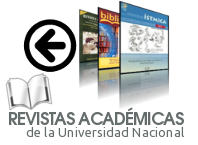Voluntary environmental standards, Nationally Appropriate Mitigation Actions and the Green Deal
Elements for discussion in the case of the coffee sector
DOI:
https://doi.org/10.15359/7f6jx993Keywords:
coffee production, environmental voluntary standards, Nationally Appropriate Mitigation Actions,, Green Deal, sustainabilityAbstract
The increased voluntary environmental standards in coffee production have been a relevant issue, especially in sustainability and global value chain behavior. Likewise, measures such as Nationally Appropriate Mitigation Actions (NAMA) and the European Union's Green Deal influence this sector. Through a literature review, this article analyzes the interrelations between voluntary standards, NAMA, and the potential to comply with Green Deal requirements, as well as the impact on the productive sector. Standards can contribute to sustainable development goals and emissions reduction, but they are not the ultimate solution to improve the conditions of primary producers. From a market access perspective, productive organizations that have applied sustainability standards and countries with NAMA strategies for the coffee sector are better prepared to comply with the Green Deal. However, the need for public policies to support the sectors, the generation of adequate financing mechanisms, and prospective studies to improve the positioning in the value chains continue to be necessary elements of action that must be strengthened in the short and medium term. Finally, there is still pending conciliation within the World Trade Organization on how these measures will be incorporated into its operating structure.
References
Barreto, J. A., Silva, J. F., Oliveira, M. B. P. P. & Alves, R. C. (2023). Sustainability issues along the coffee chain: From the field to the cup. Comprehensive Reviews in Food Science and Food Safety, 22(1), 287-332. https://ift.onlinelibrary.wiley.com/doi/
epdf/10.1111/1541-4337.13069
DeFries, R. S., Fanzo, J., Mondal, P., Remans, R. & Wood, S. A. (2017). Is voluntary certification of tropical agricultural commodities achieving sustainability goals for small-scale producers? A review of the evidence. Environmental Research Letters, 12(3). https://iopscience.iop.org/
article/10.1088/1748-9326/aa625e/pdf
Dietz, T., Estrella Chong, A., Grabs, J. & Kilian, B. (2019). How Effective is Multiple Certification in Improving the Economic Conditions of Smallholder Farmers? Evidence from an Impact Evaluation in Colombia’s Coffee Belt. The Journal of Development Studies, 56(6), 1141-1160. https://www.tandfonline.com/doi/full/10.1080/00220388.2019.1632433?scroll=top&needAccess=true
Dietz, T. & Grabs, J. (2021). Additionality and Implementation Gaps in Voluntary Sustainability Standards. New Political Economy, 27(2), 203-224. https://www.tandfonline.com/doi/full/10.1080/13563467.2021.1881473?scroll=top&needAccess=true
Elliott, K. A. (2018). What Are We Getting from Voluntary Sustainability Standards for Coffee? CDG Policy Paper, 129. https://www.cgdev.org/sites/default/files/what-are-we-gettingvoluntary-sustainability-standards-coffee.pdf
Morin, J., Orsini, A. & Jinnah, S. (2020). Trade and the environment (capítulo 10). En: Global EnvironmentalPolitics: Understanding the Governance of the Earth. Oxford: Oxford University Press.
Sanahuja, J. A. (2021). Pacto Verde Europeo: El giro ambiental de un actor global. En: Mesa, M. (coord.).El mundo después de la pandemia: Enfrentar la desigualdad y proteger el planeta. Madrid:CEIPAZ/Fundación Cultura de Paz. https://ceipaz.org/wp-content/uploads/2021/06/
ANUARIO-DEF.pdf
Silva, J. F., Oliveira, M. B. P. P. & Alves, R. C. (2021). Rotulagem do café e certificações de sustentabilidade Significado e importância para a sociedade. Cadernos de Ciência & Tecnologia, 38(2), 26761.https://seer.sct.embrapa.br/index.php/cct/article/view/26761/14868
Sociedad Alemana para la Cooperación Internacional (GIZ) (2019). NAMA Café de Costa Rica:Hacia un sector café bajo en emisiones. https://www.giz.de/en/downloads/giz2019_es_Factsheet_NAMA%20Cafe.pdf
Solér, C., Sandström, C. & Skoog, H. (2017). How Can High-Biodiversity Coffee Make It to the MainstreamMarket? The Performativity of Voluntary Sustainability Standards and Outcomes for CoffeeDiversification. Environmental Management, 59(2), 230-248. https://d-nb.info/1120977991/34
Huggins, R., & Thompson, P. (2022). Human agency, network dynamics and regional development: the behavioural principles of new path creation. Regional Studies,57(8). https://doi.org/10.1080/00343404.2022.2060958
Kurikka, H., Kolehmainen, J., Sotarauta, M., Nielsen, H., & Nilsson, M. (2022). Regional opportunity spaces – observations from Nordic regions. Regional Studies, 57(8). https://doi. org/10.1080/00343404.2022.2107630
MacKinnon, D., Dawley, S., Pike, A., & Cumbers, A. (2019). Rethinking Path Creation: A Geographical Political Economy Approach. Economic Geography, 95(2), 113-135. https://doi.org/10.1080/00130095.2018.1498294
Martin, R., & Sunley, P. (2006). Path dependence and regional economic evolution. Journal of Economic Geography, 6(4), 395-437. https://doi.org/10.1093/jeg/lbl012
Massey, D. (2005). For space. London: Sage.
Mintrom, M., & Rogers, B. (2022). How can we drive sustainability transitions? Policy design and practice, 5(3), 294-306. https://doi.org/10.1080/25741292.2022.2057835
Rinkinen, S., Konsti-Laakso, S., & Lahikainen, K. (2023). University as an opportunity space enabler in a regional entrepreneurial ecosystem. European Planning Studies. https://doi.org/10.1080/09654313.2023.2246522
Mintrom, M., & Rogers, B. (2022). How can we drive sustainability transitions? Policy design and
practice, 5(3), 294-306. https://doi.org/10.1080/25741292.2022.2057835
Rinkinen, S., Konsti-Laakso, S., & Lahikainen, K. (2023). University as an opportunity space
enabler in a regional entrepreneurial ecosystem. European Planning Studies. https://doi.org
/10.1080/09654313.2023.2246522
Steen, M. (2016). Reconsidering path creation in economic geography: aspects of agency,
temporality and methods. European Planning Studies, 24(9), 1605-1622. https://doi.org/10.
/09654313.2016.1204427
Truffer, B., & Coenen, L. (2012). Environmental Innovation and Sustainability Transitions in Regional Studies. Regional Studies, 46(1), 1-21. https://doi.org/10.1080/00343404.2012.646164






